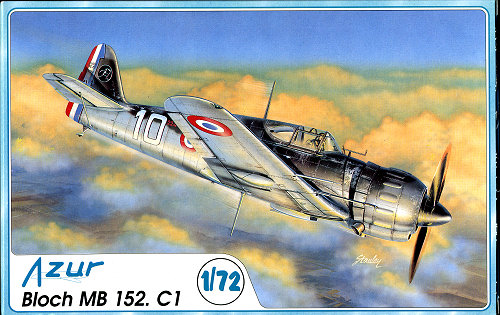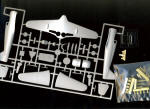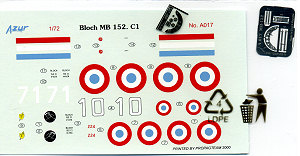
| KIT: | Azur 1/72 Bloch MB 152C-1 |
| KIT #: | 017 |
| PRICE: | $16.10 from GreatModels |
| DECALS: | Two options |
| REVIEWER: | Scott Van Aken |
| NOTES: | Short run multimedia kit |

| HISTORY |
The MB-150 was a French low-wing, all-metal monoplane fighter aircraft with retractable landing gear and closed cockpit developed by Société des Avions Marcel Bloch as a contender in the 1934 French air ministry competition for a new fighter design.
Although the competition was won by the prototype Morane-Saulnier M.S.406, development proceeded culminating in the first attempted flight of the MB.150.01 prototype in 1936. Unfortunately, the plane proved unable to leave the ground! With modifications consisting of a strengthened wing of greater area, revised landing gear, and installation of a 940 hp (701 kW) Gnome-Rhone 14N-0 radial engine with a three-blade constant speed propeller, the MB.150 finally flew in October of 1937.
Handed over to the Centre d'Essais du Materiel Aerien (CEMA) for service trials, its performance proved sufficiently interesting to warrant further development. This brought, at the very beginning of 1938, a small increase in wing span and installation of a 14N-7 engine. When trials were completed in the late spring of 1938, SNCASO was awarded an order for a pre-production batch of 25 of these aircraft.
No such production of the MB-150.01 ever occurred, the plane being totally unsuitable to mass production. Redesign would lead to the MB.151.01 and MB.152.01 prototypes, developed and produced in parallel. By the outbreak of World War II, some 120 had reached the Armée de l'Air, but few of them were flyable, most missing their gunsights and propellers.
The MB.153 and MB.154 were intended as testbeds for American engines, but only the former flew, and when it crashed a few days later, damaged beyond repair, pursuit of these alternatives also ceased. Instead, attention shifted to extending the range of the MB.152. This was achieved by moving the cockpit aft in order to make room for a new fuel tank. Other modifications included a slightly broader wing and revised aerodynamics around the cowling. The result, designated MB.155 performed favourably in flight tests and was ordered into production in 1940, however only 10 aircraft had been completed by the fall of France. Under the terms of the armistice, the remaining 19 on the production line were completed and delivered into Vichy service. From there, some eventually made their way into the Luftwaffe after 1942.
The final member of the family, the MB.157 utilised a far more powerful engine and eventually became a very different aircraft as the design evolved from the MB.152 to accommodate the larger and heavier powerplant. Unfinished at the time of the armistice, it was ordered to be completed and flown under German supervision. Demonstrating superb performance, it was taken to Orly where the powerplant was removed for testing within a wind tunnel. The excellence in the design was confirmed. It was later destroyed in an allied air raid.
MB.151s and MB.152s equipped six fighter Groupes during the Battle of France, but proved completely outclassed by the Messerschmitt Bf 109E. They continued to fly in the Vichy air force until this was disbanded. Some of these aircraft were then supplied to Romania, which flew them against the Russians.
Nine MB.151s were exported to Greece. They flew against the Italian and Germans scoring several air-to-air victories.
| THE KIT |
 Upon
opening the reasealable bag, I was confronted by a kit that looked more
appropriate to about 10 years ago than what MPM/Special Hobby/Azur are capable
of producing today. Not that it is bad, as the surface detailing is quite good,
just that it looks like an older design kit. The cockpit consists of a floor,
seat, stick and center console with rudder pedals. An etched instrument panel
sandwitches an acetate instrument sheet with the plastic panel back. A plain
rear bulkhead and shelf complete the interior. The single vacuformed canopy is
fairly good, but somewhat soft in detail.
Upon
opening the reasealable bag, I was confronted by a kit that looked more
appropriate to about 10 years ago than what MPM/Special Hobby/Azur are capable
of producing today. Not that it is bad, as the surface detailing is quite good,
just that it looks like an older design kit. The cockpit consists of a floor,
seat, stick and center console with rudder pedals. An etched instrument panel
sandwitches an acetate instrument sheet with the plastic panel back. A plain
rear bulkhead and shelf complete the interior. The single vacuformed canopy is
fairly good, but somewhat soft in detail.
The engine is resin with a separate crankcase and
single cylinders. Resin is also uses for a few of the additional cowling bumps
that would normally be sanded down when one assembles the two piece cowling. A
rather thoughful feature. Though the instructions don't mention it, the engine
should be mounted to where the thrust line is a few degrees off centerline, to
the left I  believe, as this was
done to help overcome torque swing. The wheel wells are devoid of detail
and are not even boxed in. Gear is a simple butt join with wheels molded in two
halves. Resin is used for the exhaust and for the various antennas and pitot
tubes, and guns. The prop is one of those with separate blades, but since they
fit into a spinner, no worries about matching up to a resin hub.
believe, as this was
done to help overcome torque swing. The wheel wells are devoid of detail
and are not even boxed in. Gear is a simple butt join with wheels molded in two
halves. Resin is used for the exhaust and for the various antennas and pitot
tubes, and guns. The prop is one of those with separate blades, but since they
fit into a spinner, no worries about matching up to a resin hub.
Markings are for two aircraft in the usual disruptive scheme of the time. One is from GC II/9, while the other is the box art plane from GC II/1, both in 1940. Decals are superbly printed by Propagteam. They provide individual rudder stripes, but the modeler would be better served to paint these on.
| CONCLUSIONS |
The only other 1/72 injected kit of this aircraft is a rather ancient Heller kit, whose availability is questionable. This one surely surpasses it in terms of detail, if not in ease of construction. Overall it is nice to see a well done kit of this important, though not very successful French WWII fighter.
| REFERENCES |
http://en.wikipedia.org
You can find this and other fine kits and accessories at GreatModels
August 2007
If you would like your product reviewed fairly and quickly by a site that has near 400,000 visitors a month, please contact me or see other details in the Note to Contributors.